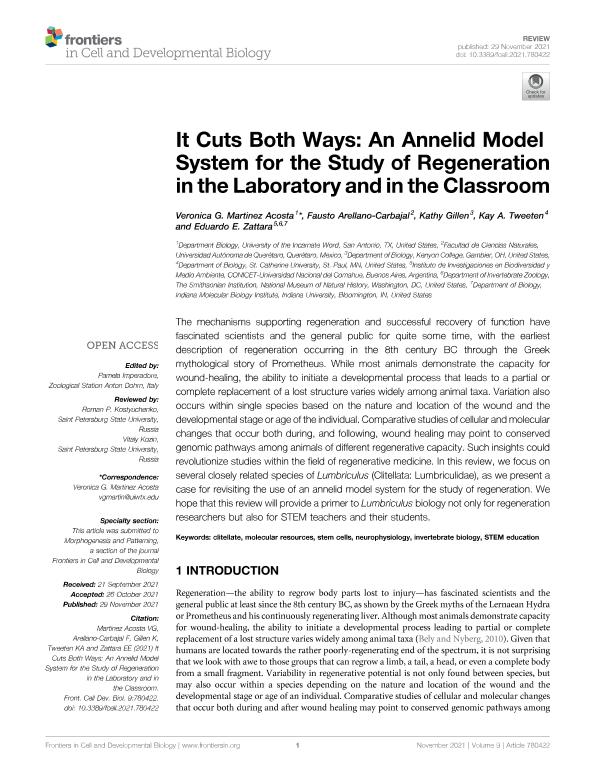Mostrar el registro sencillo del ítem
dc.contributor.author
Martinez Acosta, Veronica G.
dc.contributor.author
Arellano Carbajal, Fausto
dc.contributor.author
Gillen, Kathy
dc.contributor.author
Tweeten, Kay A.
dc.contributor.author
Zattara, Eduardo Enrique

dc.date.available
2023-01-05T17:53:03Z
dc.date.issued
2021-11
dc.identifier.citation
Martinez Acosta, Veronica G.; Arellano Carbajal, Fausto; Gillen, Kathy; Tweeten, Kay A.; Zattara, Eduardo Enrique; It Cuts Both Ways: An Annelid Model System for the Study of Regeneration in the Laboratory and in the Classroom; Frontiers Media; Frontiers in Cell and Developmental Biology; 9; 780422; 11-2021; 1-16
dc.identifier.uri
http://hdl.handle.net/11336/183574
dc.description.abstract
The mechanisms supporting regeneration and successful recovery of function have fascinated scientists and the general public for quite some time, with the earliest description of regeneration occurring in the 8th century BC through the Greek mythological story of Prometheus. While most animals demonstrate the capacity for wound-healing, the ability to initiate a developmental process that leads to a partial or complete replacement of a lost structure varies widely among animal taxa. Variation also occurs within single species based on the nature and location of the wound and the developmental stage or age of the individual. Comparative studies of cellular and molecular changes that occur both during, and following, wound healing may point to conserved genomic pathways among animals of different regenerative capacity. Such insights could revolutionize studies within the field of regenerative medicine. In this review, we focus on several closely related species of Lumbriculus (Clitellata: Lumbriculidae), as we present a case for revisiting the use of an annelid model system for the study of regeneration. We hope that this review will provide a primer to Lumbriculus biology not only for regeneration researchers but also for STEM teachers and their students.
dc.format
application/pdf
dc.language.iso
eng
dc.publisher
Frontiers Media

dc.rights
info:eu-repo/semantics/openAccess
dc.rights.uri
https://creativecommons.org/licenses/by/2.5/ar/
dc.subject
CLITELLATE
dc.subject
INVERTEBRATE BIOLOGY
dc.subject
MOLECULAR RESOURCES
dc.subject
NEUROPHYSIOLOGY
dc.subject
STEM CELLS
dc.subject
STEM EDUCATION
dc.subject.classification
Biología del Desarrollo

dc.subject.classification
Ciencias Biológicas

dc.subject.classification
CIENCIAS NATURALES Y EXACTAS

dc.subject.classification
Zoología, Ornitología, Entomología, Etología

dc.subject.classification
Ciencias Biológicas

dc.subject.classification
CIENCIAS NATURALES Y EXACTAS

dc.title
It Cuts Both Ways: An Annelid Model System for the Study of Regeneration in the Laboratory and in the Classroom
dc.type
info:eu-repo/semantics/article
dc.type
info:ar-repo/semantics/artículo
dc.type
info:eu-repo/semantics/publishedVersion
dc.date.updated
2022-10-06T13:12:14Z
dc.identifier.eissn
2296-634X
dc.journal.volume
9
dc.journal.number
780422
dc.journal.pagination
1-16
dc.journal.pais
Suiza

dc.journal.ciudad
Lausanne
dc.description.fil
Fil: Martinez Acosta, Veronica G.. University Of The Incarnate Word; Estados Unidos
dc.description.fil
Fil: Arellano Carbajal, Fausto. Universidad Autonoma de Queretaro.; México
dc.description.fil
Fil: Gillen, Kathy. Kenyon College; Estados Unidos
dc.description.fil
Fil: Tweeten, Kay A.. St. Catherine University; Estados Unidos
dc.description.fil
Fil: Zattara, Eduardo Enrique. Consejo Nacional de Investigaciones Científicas y Técnicas. Centro Científico Tecnológico Conicet - Patagonia Norte. Instituto de Investigaciones en Biodiversidad y Medioambiente. Universidad Nacional del Comahue. Centro Regional Universidad Bariloche. Instituto de Investigaciones en Biodiversidad y Medioambiente; Argentina. Indiana University; Estados Unidos. National Museum Of Natural History. Departamento de Zoología. Area de Invertebrados; Estados Unidos
dc.journal.title
Frontiers in Cell and Developmental Biology
dc.relation.alternativeid
info:eu-repo/semantics/altIdentifier/url/https://www.frontiersin.org/articles/10.3389/fcell.2021.780422/full
dc.relation.alternativeid
info:eu-repo/semantics/altIdentifier/doi/http://dx.doi.org/10.3389/fcell.2021.780422
Archivos asociados
